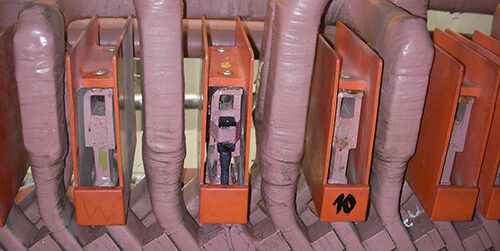
ENDWINDING MONITORING

Description
Current operating practices place severe thermal and mechanical stresses on the rotors and stators of large pump storage hydro and turbo generators. These practices involve multiple daily run-ups and run-downs of the machines, which can lead to premature aging and cycle-related deterioration of the stator windings.
Pump storage, hydro-generator, and nuclear turbo-generator designs are characterized by extremely long endwinding assemblies and complex spacer systems. These systems are subject to high mechanical and electrical stresses, predominantly excited by electromagnetic forces due to the interaction of a magnetic field and an electrical current.
To extend the service life of generators and increase their availability, continuous monitoring of the endwinding structures and stator bars is essential. Monitoring allows for the early detection of any foreseeable deterioration in structural integrity, enabling proactive maintenance and reducing the risk of unexpected failures.
Typical faults detections
Our Endwinding Monitoring solutions are meticulously designed to address the challenges posed by these severe operational conditions. By focusing on key faults that could compromise generator performance, our systems ensure that potential issues are identified before they lead to costly repairs or downtime:
- Vibration-Induced Fatigue: Continuous vibrations, especially during frequent run-ups and run-downs, can lead to mechanical fatigue in the endwindings. Early detection through monitoring can prevent cracks or insulation failures from developing.
- Loose or Misaligned Windings: Misalignment or loosening of the windings can result from the mechanical stresses experienced during operation. By monitoring these conditions, our solutions ensure that these issues are detected and rectified before they cause significant damage.
- Loosening of Endwinding Support: The endwinding support structures are crucial for maintaining the stability and integrity of the windings. If these supports loosen, it can lead to increased vibrations and potential damage. Our monitoring systems detect early signs of support loosening, enabling timely maintenance.
- Wear of Insulation: Continuous vibrations can cause wear on the insulation protecting the windings. This wear can lead to electrical faults, including short circuits. By monitoring vibration levels, our systems help predict and prevent insulation wear, maintaining the electrical integrity of your generator.
- Fatigue Cracking of Conductors: The conductors within the windings are subject to mechanical stress from continuous operation. Over time, this stress can lead to fatigue cracking, potentially causing serious failures. Monitoring allows for early detection of conditions that could lead to conductor fatigue, ensuring that preventive actions can be taken.
- Resonance Conditions: High mechanical stresses, combined with the electromagnetic forces within the generator, can lead to resonance, where vibrations are amplified, increasing the risk of structural failure. Continuous monitoring helps in identifying and mitigating these resonance conditions.
- Structural Deterioration: The complex spacer systems and other structural components of the endwinding assemblies are crucial for maintaining mechanical integrity. Monitoring the condition of these components is essential to detect any deterioration early and plan maintenance accordingly.
Monitoring parameters
In the challenging environments of pump storage, hydro-generator, and nuclear turbo-generator systems, monitoring the right parameters is critical for maintaining the structural integrity of endwindings:
- Acceleration Monitoring: Acceleration monitoring is vital for capturing the intensity and frequency of vibrations within the endwindings. Given the extreme operational stresses, understanding these vibrations is crucial for detecting abnormal conditions that could indicate mechanical issues. Monitoring acceleration helps in identifying trends and anomalies in vibration patterns, providing valuable data that can inform maintenance decisions and prevent potential failures.
- Displacement Monitoring: Displacement monitoring focuses on the physical movement within the endwindings, which is critical for detecting shifts or misalignments caused by mechanical stresses. This is particularly important in systems with long endwinding assemblies, where even minor displacements can lead to significant issues. By monitoring displacement, you can detect early signs of mechanical wear or misalignment, enabling timely interventions that can prevent further structural damage.
Why Endwinding Monitoring is Essential
- Preventive Maintenance: Continuous monitoring allows for the early detection of faults, enabling planned maintenance rather than reactive repairs. This approach helps in minimizing unplanned outages and extends the operational life of your equipment.
- Enhanced Operational Efficiency: By ensuring that the generator operates within safe mechanical limits, monitoring helps maintain optimal efficiency and reduces the risk of energy losses due to mechanical inefficiencies.
- Safety and Reliability: Continuous monitoring of endwinding structures is not just about maintaining efficiency—it's also about ensuring the safety and reliability of your operations. Early fault detection is critical to preventing catastrophic failures and ensuring the long-term integrity of your assets.
Related sensors
LET'S KEEP IN TOUCH
Sign up to receive our newsletters














